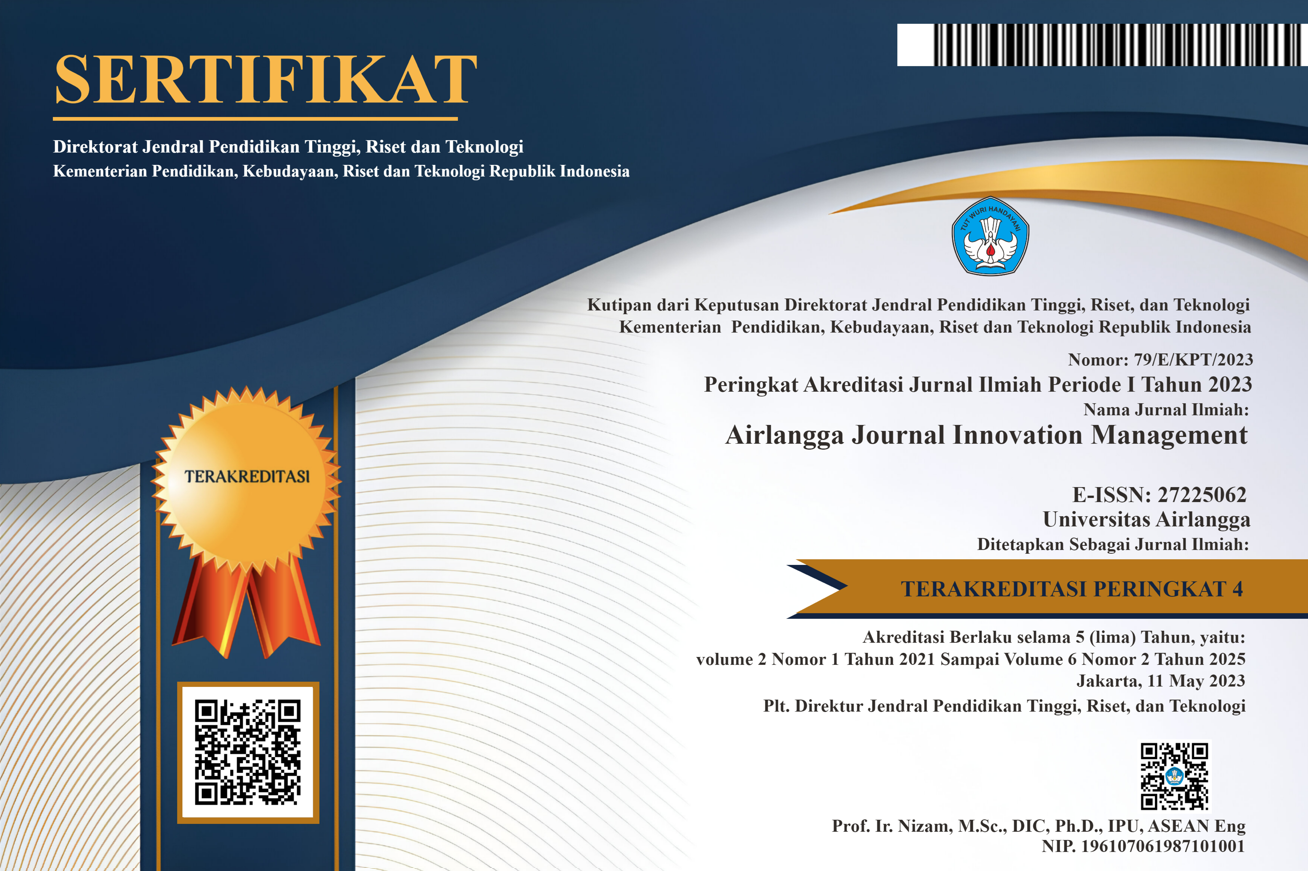The Influence of Convenience, Benefits, and Security on Consumer Preferences in Adopting QRIS Non-Cash Payments
Downloads
This study aims to determine the influence of convenience, Benefits, and security on consumer preferences in using QRIS as a non-cash payment system. This study uses a quantitative approach with a purposive sampling technique, namely a sampling method based on certain considerations or criteria relevant to the research objectives so that the selected respondents truly match the required characteristics. The number of respondents in this study was 100 people who had met these criteria. Data collection was carried out through an online questionnaire, while data analysis included validity, reliability, normality, multicollinearity tests, T-tests, F-tests, and coefficients of determination processed using SPSS version 2025. The results of the study indicate that ease, Benefits, and security each have a positive and significant effect on consumer preferences in using QRIS. The easier QRIS is to operate, the more consumers are interested in adopting it. Likewise, the greater the perceived benefits, the stronger the tendency for consumers to prefer QRIS as a payment method. In addition, a secure system fosters greater consumer trust, thereby increasing the likelihood of usage. Collectively, these three factors ease, Benefits, and security interact to enhance consumer interest and decision-making in adopting QRIS. The practical implication of these findings is that service providers and policymakers should prioritize the continuous improvement of system usability, perceived benefits, and security features to strengthen consumer trust and encourage wider adoption of QRIS in daily transactions
Al-Qudah, A. A., Al-Okaily, M., Shiyyab, F. S., Taha, A. A. D., Almajali, D. A., Masa’deh, R., & Warrad, L. H. (2024). Determinants of Digital Payment Adoption Among Generation Z: An Empirical Study. Journal of Risk and Financial Management, 17(11), 521. https://doi.org/10.3390/jrfm17110521
Alvira, R., Iqbal, M., & Dedi Satriawan. (2025). Analisis pengaruh persepsi kemudahan, keamanan, dan kualitas pelayanan penggunaan QRIS terhadap inklusi keuangan generasi z di coffee shop Bandar Lampung dalam perspektif ekonomi Islam. AL-Muqayyad, 8(1), 93–108. https://doi.org/10.46963/jam.v8i1.2751
Amelita Ika Sari, et al. (2025). Pengaruh Kemudahan, Kemanfaatan dan Keamanan Terhadap Preferensi Konsumen DalamMenggunkana QRIS Sebagai Sitem Pembayaran Non Tunai. Juremi: Jurnal Riset Ekonomi, 4(5), 1077–1088.
Amri, A., Malik, R. F., & Fachrandi, M. K. (2025). Determinants Influencing QRIS Adoption as a Digital Payment Tool in Ciledug, Tangerang City. Airlangga Journal of Innovation Management, 6(1), 154–170. https://doi.org/10.20473/ajim.v6i1.70331
Apriani, M., Antika, R., Haerani, S., & Chaidir, T. (2024). A Systematic Literature Review: The Impact of the Use of E-Money as a Non-Cash Payment Instrument on the Stability of the Indonesian Financial System. Journal of Finance, Economics and Business, 3(2), 1–18. https://doi.org/10.59827/jfeb.v3i2.160
Asaif, J. M., Suripto, S., Wardianto, K. B., & Wulandari, J. (2025). The Influence of Digital Financial Literacy, Perceived Ease of Use, Perceived Usefulness, Social and Political on The Intention and Use Behavior of Using QRIS as a Payment System in Traditional Retail. The Eastasouth Journal of Social Science and Humanities, 2(03). https://doi.org/10.58812/esssh.v2i03.587
Bachri, A. A., Maulida, M., Sari, Y., & Sunardi, S. (2025). Analyzing Influence Factors of Consumers Switching Intentions from Cash Payments to Quick Response Code Indonesian Standard (QRIS) Digital Payments. International Journal of Financial Studies, 13(2), 61. https://doi.org/10.3390/ijfs13020061
Basir, A., Muchran, M., Makassar, U. M., & Author, C. (2025). Challenges and Opportunities for Non-Cash Payments in the Era. International Journal of Economic Research and Financial Accounting (IJERFA) Volume, 3(4), 871–876.
Budiwitjacksono, G. S., & Septa, A. (2023). Perceived Ease and Security of Using Qris Towards Cashless Society. IJEBD (International Journal of Entrepreneurship and Business Development), 6(4), 725–738. https://doi.org/10.29138/ijebd.v6i4.2308
Bustamir, A., Hidayati, A., Febriyanti, N., & Ritonga, I. (2025). Enrichment : Journal of Multidisciplinary Research and Development Effectiveness of Qris on Payment Efficiency Systems in Perspective of Maslahah Mursalah. Enrichment: Journal of Multidisciplinary Research and Development, 3(3), 341–348. https://doi.org/10.55324/enrichment.v3i3.385
Galang, J., & Ramdhan, H. (2023). Analysis of the Acceptance Level of E-Wallet as a Non-Cash Payment Method among Indonesian Students. IAIC Transactions on Sustainable Digital Innovation (ITSDI), 5(1), 67–75. https://doi.org/10.34306/itsdi.v5i1.611
Gunawan, A., Fatikasari, A. F., & Putri, S. A. (2023). The Effect of Using Cashless (QRIS) on Daily Payment Transactions Using the Technology Acceptance Model. Procedia Computer Science, 227, 548–556. https://doi.org/10.1016/j.procs.2023.10.557
Halizah, N. A., M. Aris Syafi’i, & Hendri Hermawan Adinugraha. (2024). Uncovering perceptions of lifestyle and convenience cashless payment for consumptive behavior generation Z Muslims. Alkasb: Journal of Islamic Economics, 3(2), 215–232. https://doi.org/10.59005/alkasb.v3i2.458
Hamzah Muchtar, E., Trianto, B., Maulana, I., Alim, M. N., Marasabessy, R. H., Hidayat, W., Junaedi, E., & Masrizal. (2024). Quick response code Indonesia standard (QRIS) E-payment adoption: customers perspective. Cogent Business & Management, 11(1). https://doi.org/10.1080/23311975.2024.2316044
Ida Bagus Gede, A. W., & Luh Putu, M. (2023). Consumer Perceptions of Benefits and Barriers of QRIS in Coffee Shop Businesses. JRMSI - Jurnal Riset Manajemen Sains Indonesia, 14(02), 91–102. https://doi.org/10.21009/JRMSI.014.2.08
Irvan, M., Dewi, M., & Setianingsih, D. (2025). Understanding undergraduate students’ adoption of QRIS: The role of benefits, risks, and convenience. Review of Business and Accounting Research, 2(1), 1–10. https://doi.org/10.62941/rbar.v2i1.95
Jebarajakirthy, C., & Shankar, A. (2021). Impact of online convenience on mobile banking adoption intention: A moderated mediation approach. Journal of Retailing and Consumer Services, 58, 102323. https://doi.org/10.1016/j.jretconser.2020.102323
Jusman, J., & Fauziah, I. (2024). Receptiveness of QRIS as a Digital Payment Among MSME in Palopo City. Interdiciplinary Journal and Hummanity (INJURITY), 3(10), 718–728. https://doi.org/10.58631/injurity.v3i10.1234
Khoirunnisa, T. I., & Abidin, A. Z. (2025). Analysis of The Impact of Using QRIS Merchant on Efficiency and Safety at UMKM in Manahan Shelter. Proceeding ISETH (International Summit on Science, Technology, and Humanity), 48–63. https://doi.org/10.23917/iseth.5301
Mashitoh, I., & Octafian, R. (2025). The Trend of Payment Method Shifts Among Gen Z from Traditional to Modern. International Journal of Applied Economics, Accounting and Management (IJAEAM), 3(3), 181–192.
Musa F. Silaen, Sepbeariska Manurung, & Christine D. Nainggolan. (2021). Effect Analysis Of Benefit Perception, Ease Perception, Security And Risk Perception Of Merchant Interest In Using Quick Response Indonesia Standard (Qris). International Journal of Science, Technology & Management, 2(5), 1574–1581. https://doi.org/10.46729/ijstm.v2i5.313
Nabila, A. P., Raharso, S., & Tiorida, E. (2025). The Influence of Trust and Transaction Security on Interest in Using The QRIS Payment System. Airlangga Journal of Innovation Management, 6(2), 248–260. https://doi.org/10.20473/ajim.v6i2.72597
Rachma, A. L., & Kusuma, P. J. (2024). Generation Z Adoption of QRIS in Semarang City : Role of Financial Risk Tolerance. Neo Journal of Economy and Social Humanities, 3(3), 174–192. https://doi.org/10.56403/nejesh.v3i3.217
Rafferty, N. E., & Fajar, A. N. (2022). Integrated QR Payment System (QRIS) : Cashless Payment Solution in Developing Country from Merchant Perspective. Asia Pacific Journal of Information Systems, 32(3), 630–655. https://doi.org/10.14329/apjis.2022.32.3.630
Rahmawati, F., & Merlinda, S. (2024). The effect of perceived benefits,ease of use, and risk on culinary MSMEs’ interest in utilizing QRIS. Journal of Business & Banking, 14(1), 19–38. https://doi.org/10.14414/jbb.v14i1.4674
Ramadhan, R., & Afandi, A. (2025). Effectiveness of Using Qris Payment As a Digital Payment Solution in Coffee Shop Business (Case Study of Circle Coffee Medan Coffee Shop). Indonesian Interdisciplinary Journal of Sharia Economics (IIJSE), 8(2), 4371–4387. https://e-journal.uac.ac.id/index.php/iijse/article/view/6750
Ramayanti, R., Azhar, Z., & Nik Azman, N. H. (2025). Factors influencing intentions to use QRIS: A two-staged PLS-SEM and ANN approach. Telematics and Informatics Reports, 17, 100185. https://doi.org/10.1016/j.teler.2024.100185
Rinaldi, A. (2025). Transformation of the Payment System Towards a Cashless Society : Definition , Benefits , and Challenges. 3(1), 526–531.
Sahir, S. H. (2022). Metodelogi penelitian, Universita Medan Area.
Saputri, O. B. (2020). Consumer Preferences in Using the Quick Response Code Indonesia Standard (QRIS) as a Digital Payment Tool’. Journals of Economics and Business Mulawarman, 17(2), 237–247.
Septiningrum, L. (2022). Theoretical Framework of Cashless Payment Systems in Indonesia: Analyzing Condition in Different Era’s. JURNAL NATAPRAJA: Kajian Ilmu Administrasi Negara, 10(2), 125–137.
Setyaningtyas, R. A., & Suranto. (2024). the Influence of Perceived Benefits, Perceived Ease of Use, and Perceived Risk on Msme Decisions in Using Qris As a Digital Payment System in Surakarta. Indonesian Interdisciplinary Journal of Sharia Economics (IIJSE), 7(2), 4611–4626.
Shintaro, M., & Bhirawa, S. W. S. (2024). Student Preference To Use Qris (Quick Response Code Indonesian Standard) As A Digital Payment Instrument. MSJ : Majority Science Journal, 2(1), 232–241. https://doi.org/10.61942/msj.v2i1.74
Sudyantara, S. C., & Yuwono, A. (2023). Mengelola penggunaan QRIS dan QRcode dalam meningkatkan kualitas layanan bagi UMKM. Insight Management Journal, 3(3), 252–258. https://doi.org/10.47065/imj.v3i3.271
Sugandi, A., Sudaryo, Y., Sofiati, N. A., & Ali, M. M. (2025). The Influence of Transaction Channel Preference and Cash Handling Behavior on the Achievement of Cash Donations in the ‘ Charity Box Personal ’ Program ( A Research at the Humanitarian Organization Kilau Indonesia ). Eduvest – Journal of Universal Studies, 5(9), 11447–11456.
Vicy Andriany, & Miftahul Zikri. (2024). Utaut’s Implementation of QRIS in the Preferences of the Community in West Sumatra. International Journal of Economics and Management Research, 3(3), 01–15. https://doi.org/10.55606/ijemr.v3i3.231
Wirabuana, C., Marbanie, R., Sensuse, D. I., Sumirat Hidayat, D., & Purwaningsih, E. H. (2024). Perceptions of the Use of Quick Response Code Indonesian Standard (QRIS) for Payment and its Impact on Consumer Behavior. Jurnal Sistem Informasi, 20(2), 1–17. https://doi.org/10.21609/jsi.v20i2.1416.
Copyright (c) 2025 Airlangga Journal of Innovation Management

This work is licensed under a Creative Commons Attribution-NonCommercial-ShareAlike 4.0 International License.
- The journal allows authors to hold copyright without restrictions and retain publication rights without restrictions. The author retains the copyright and grants the first publication rights to the journal, with his work simultaneously licensed under the Creative Commons Attribution-NonCommercial-ShareAlike 4.0 International License (CC BY-NC-SA). This license allows others to share the work with acknowledgment of authorship and initial publication in this journal, provided that the work is not used for commercial purposes and that any derivative works must use the same license.
- Authors may enter into additional contractual agreements for non-exclusive distribution of the journal publication version (e.g., uploading it to an institutional repository or publishing it in book form), while still including acknowledgment of the initial publication in this journal.
- Authors are allowed and encouraged to upload their work online (e.g., in an institutional repository or personal website) before and during the submission process. This can support productive scientific exchanges as well as increase citations to published works.

AJIM by UNAIR is licensed under a Creative Commons Attribution-NonCommercial-ShareAlike 4.0 International License.





















